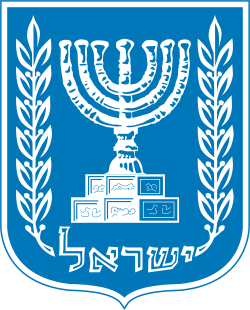Tehiya
Tehiya (Hebrew: תחיה, Revival), originally known as Banai (Hebrew: בנא"י, an acronym for Land of Israel Loyalists' Alliance (Hebrew: ברית נאמני ארץ ישראל)), then Tehiya-Bnai (Hebrew: תחייה-בנא"י), was an ultranationalist political party in Israel. The party existed from 1979 until 1992. In the eyes of many, Tehiya was identified with Geula Cohen, who founded the party and headed it throughout its existence.
Tehiya תחיה | |
|---|---|
.png) | |
| Leader | Geula Cohen Yuval Ne'eman |
| Founded | 1979 |
| Dissolved | 1992 |
| Split from | Herut |
| Merged into | Likud |
| Ideology | Ultranationalism[1] Settler interests Revisionist Zionism |
| Political position | Right-wing[2] to far-right[3] |
| Most MKs | 5 (1984) |
| Election symbol | |
| ת | |
Background

The party was formed in 1979 during the term of the ninth Knesset, when Geula Cohen and Moshe Shamir broke away from Herut in response to the Camp David Treaty between Egypt and Israel, particularly to the surrender of the Sinai peninsula to Egypt, and the eviction of its Israeli residents.[4]
Tehiya was strongly affiliated with the extra-parliamentary movement of Gush Emunim,[4] and included prominent members of Israeli settlements in the West Bank and Gaza such as Hanan Porat (later to be a member of the Knesset for the National Religious Party and the National Union) and Elyakim Haetzni. Another founder and prominent member was the physicist Yuval Neeman.[5]
In its first electoral test, the 1981 legislative election, Tehiya picked up three seats. Despite their previous difference of opinion, they were included in Menachem Begin's coalition government alongside Likud, the National Religious Party, Agudat Israel, Tami and Telem. Although Cohen did not take a ministerial position, Neeman became Minister of Science and Development.[5]
In the 1984 elections, Tehiya became the third largest party in the Knesset after the Alignment and Likud, albeit with only five seats. However, they refused to participate in the national unity government of Shimon Peres and Yitzhak Shamir, which included the Alignment, Likud, the National Religious Party, Agudat Israel, Shas, Morasha, Shinui and Ometz.[6] During the Knesset session Rafael Eitan defected from Tehiya to found a new party, Tzomet.[7]
The party was reduced to three seats in the 1988 legislative election, and was again excluded from Shamir's national unity government. However, when the Alignment left the coalition in 1990, Tehiya were invited into a new narrow right-wing government which included Likud, the National Religious Party, Shas, Agudat Israel, Degel HaTorah, the New Liberal Party.[8] Although Cohen again declined a ministerial position, Neeman was appointed Minister of Energy and Infrastructure and Minister of Science and Technology. Despite its late entry to the government, the party pulled out of the coalition on 21 January 1992 in protest over Yitzhak Shamir's participation in the Madrid conference, which forced the government to hold new elections.[9]
In the 1992 legislative election, the party failed to cross the electoral threshold, and subsequently disappeared, with Cohen joining Likud that year. It is likely that most of its electorate went to Eitan's Tzomet, who jumped from two seats in the 1988 elections to eight in the 1992 votes. The two parties had competed on the same secular right-wing electorate.[8]
Tehiya fronted a number of controversial positions in its time, some of which were adopted by the mainstream; most notably, the Jerusalem Law, which was proposed by the party and enacted on 30 July 1980 establishing Jerusalem as the capital of the State of Israel.[10]
Structure
The structure of Tehiya was based on a military model due to Gideon Altshuler, former head of an IDF brigade being made Secretary General, and Shmuel Gordan a former Lieutenant Colonel being made head of organization.[11] The party only allowed Jewish members.[5]
 |
|---|
| This article is part of a series on the politics and government of Israel |
|
Constitution |
|
|
Judiciary
|
|
Administrative divisions
|
|
|
|
Knesset members
| Knesset (MKs) |
Knesset members |
|---|---|
| 9th (2) |
Geula Cohen, Moshe Shamir |
| 10th (3) |
Geula Cohen, Yuval Neeman, Hanan Porat (replaced by Zvi Shiloah) |
| 11th (5 −1) |
Geula Cohen, Yuval Neeman, Gershon Shafat, Eliezer Waldman − Rafael Eitan (to Tzomet) |
| 12th (3) |
Geula Cohen, Yuval Neeman (replaced by Elyakim Haetzni), Eliezer Waldman (replaced by Gershon Shafat) |
Election platform
The Tehiya platform at the 1988 elections included:[12]
- Jewish sovereignty over the Sinai, Judea and Samaria and Gaza
- Increase of the number of Jews living in all quarters of the Old City of Jerusalem
- Strengthening of the IDF, including technical development and severe punishment for refusal to serve
- Support and increase for the settlements of the West Bank and Gaza, including establishment of a special police force
- Clemency for Jews convicted of crimes committed due to "security distress"
- Peace agreements only with Arab states who acquiesce to Jewish control over the entirety of the Land of Israel
- Jordan being the Palestinian State, all attempts to create a Palestinian state west of the Jordan River are to be prevented
- Cancellation of the access of Palestinians to the High Court of Justice
- Death penalty for severe cases of violence by Palestinians
- Licence for Israeli soldiers to shoot stone throwers
- Punishments of Palestinians to include collective punishments
- Wide access roads through the casbahs of Palestinian cities
References
- Sharon Weinblum (2015). Security and Defensive Democracy in Israel: A Critical Approach to Political Discourse. Routledge. p. 10. ISBN 978-1-317-58450-6.
- "Tehiya Threatens to Quit Coalition Unless Government Moves on Intifada". Jewish Telegraphic Agency. 9 August 1990.
- Jonathan Mendilow (2003). Ideology, Party Change, and Electoral Campaigns in Israel, 1965-2001. SUNY Press. p. 142. ISBN 978-0-7914-5587-6.
- Peretz, Don (1997). The Government and Politics of Israel. WestviewPress. ISBN 9780813324098.
- Tessler, Mark A. (1994). A History of the Israeli-Palestinian Conflict. Indiana University Press. p. 646. ISBN 9780253208736.
Hanan Porat tehiya.
- Political Risk Yearbook: Middle East & North Africa. Frost & Sullivan. 2001.
- Lansford, Tom (31 March 2017). Political Handbook of the World 2016-2017. CQ Press. ISBN 9781506327174.
- Peretz, Donald (19 February 2018). The Government And Politics Of Israel: Third Edition. Routledge. ISBN 9780429974120.
- Jones, Clive; Murphy, Emma C. (25 July 2005). Israel: Challenges to Identity, Democracy and the State. Routledge. ISBN 9781134488841.
- Lukacs, Yehuda; East, International Center for Peace in the Middle (1992). The Israeli-Palestinian Conflict: A Documentary Record, 1967-1990. Cambridge University Press. ISBN 9780521375979.
- Mahler, Gregory S. (1 February 2012). Israel After Begin. SUNY Press. ISBN 9781438411699.
- Yehuda Lukacs (1991). The Israeli-Palestinian conflict: a documentary record. Cambridge University Press. pp. 286–289. ISBN 978-0-521-37597-9.